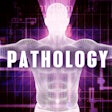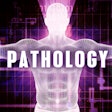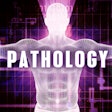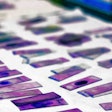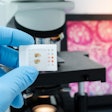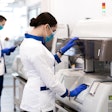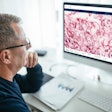
Reports of a decline in the number of working pathologists and in applications from medical students to the specialty have understandably raised alarm. But are the problems as bad as they seem, and, if so, what can be done to improve the image and attraction of pathology?
In an editorial published in a recent issue of the Archives of Pathology & Laboratory Medicine, Dr. Ian Harrold, a fellow in transfusion medicine at the University of Pittsburgh Medical Center (UPMC), and colleagues analyzed data on first-year pathology positions and suggested ways for the specialty to become more visible within and outside of medicine.
 Dr. Ian Harrold from UPMC.
Dr. Ian Harrold from UPMC.Data in the U.S. showed that the percentage of total positions filled by medical graduates in pathology has been on the decline since the late 1970s, but the ratio of those choosing pathology versus the total number graduating has only "mildly fluctuated," Harrold and colleagues wrote (Arch Pathol Lab Med, August 2019, Vol. 143:8, pp. 917-918). The authors still see room for improvement, however.
"Medical students think of pathology as a clinically invisible specialty and are unaware of it, forget about it, or ignore it as a career path," they wrote. "Therefore, students are not rejecting pathology; it simply is not included in their slate of career options."
In a recent interview, LabPulse.com spoke with Harrold about workforce issues and how pathologists can come out of the proverbial basement.
LabPulse: What are the best sources for information about the pathology workforce?
Harrold: I don't know if I have any great resources beyond just talking to other pathologists, which is part of the problem. I don't think there is a great, easy resource. It's not that well known a field outside of the medical world, and even inside the medical world.
Why does there appear to be some difference of opinion on the state of the pathology workforce?
What our article is trying to say is that there is often concern in a lot of pathology residency programs that there are less and less applicants applying, especially from U.S. medical schools. At least that is the way it feels. But looking at the data the way we analyzed it, it has been relatively stable in [terms of] how many people are applying. Every year, between 1% and 2% of U.S. medical graduates apply to pathology, and it's stayed like that since the '80s. There is still poor understanding of the field, both in the public eye and even among other medical professionals. A lot of my colleagues who didn't go into pathology don't really know what the field is. A lot of med students don't know it is an option.
So, should pathologists be concerned?
Right now, being very concerned about it might be an overreaction, but knowing it is a place where we could have improvement is definitely the best way to focus our energies at this point. It is an opportunity for us to find more ways to become more visible.
Can you give examples of what can be done in terms of medical education?
Part of the problem is there is only so much time, and every specialty wants to have their time with med students and every specialty is important. Pathology is just as important as these other fields and deserves to have a percentage of time to explain what the field is, to understand what laboratory medicine is as a whole.
Because for a lot of med students, the laboratory is a black box. They get a blood sample, send it down [to the lab]; a couple hours later, a few days later they get a result. Understanding technicians and physicians who work down there is very important. Some med schools have started to do tours of pathology labs. Those are great opportunities to get medical students to see a lab and how it works. Having these presentations in the first year of med school is very important.
A lot of med schools have interest groups for most specialties. It's good to make sure [the groups for] pathology are very present and visible, that they are doing tours of labs and hands-on activities -- blood typing or fine-needle aspiration practice, or going down to the gross pathology room and seeing the specimens as they come out of the OR.
Is improving visibility more a goal with other health professionals, with the general public, or both?
My main focus is more on health professionals than the public eye. But the public also has a very skewed view of pathology.
Right now, when I am teaching pathology topics to other residents or fellows or med students, most have no idea about the tests they themselves are ordering. They are ordering blood but don't understand how the blood bank works. They get a biopsy done, but they don't know the process or why it takes the number of days it does.
In the public eye, pathology is very poorly understood. It's usually just shown as autopsy, which is an important aspect of pathology, but not the only part. The people they show on medical and crime TV shows are often quirky and strange. It gives off the stereotype that pathologists are weird people who don't like talking to other people, which is not the case at all.
Are you concerned about workload?
I don't believe there is a problem with too much work to go around. There are physician shortages across the board, but I don't think pathology is hit any worse than anyone else is right now.
There's a lot of talk about how pathologists should get more involved in making sure that the right tests are ordered. To what extent is that actually happening in practice?
I can't speak across the board, but in my experience it sometimes happens. Pathologists are kind of the gatekeepers to the lab, but pathologists have gotten some pushback. If the clinical team really wants the test done, they usually have made up their mind before they have consulted with us. There needs to be more of a cultural change.
How do pathologists compare with other specialties in terms of engagement on social media?
There seems to be a growing interest in social media engagement among pathologists. There are definitely some pathologists who are very prolific. Pathology is very much a visual specialty -- most of what we do is interpretation of microscopic slides. You can easily take pictures of those with a cellphone camera through the microscope and a lot of microscopes have cameras built in. Deidentified pictures are easily shareable for teaching and consultation purposes to get unofficial second opinions.
What opportunities does the era of personalized medicine and direct-to-consumer testing provide for pathologists?
This is where pathologists can be the ones to understand these tests and really be the ones to consult with patients -- maybe even directly -- on what tests do, how much they cost, and what information you get.
Pathologists are in a unique position to understand the laboratory side of this better than most other physicians and to really be the gatekeepers.











